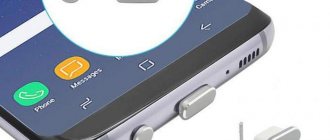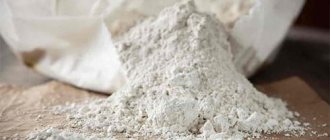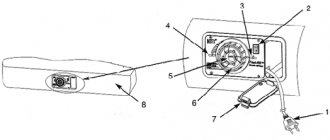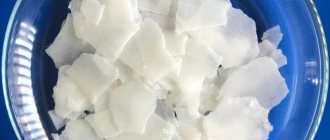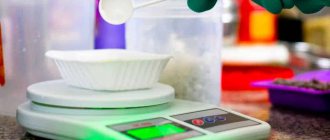Sodium bicarbonate, sodium bicarbonate, sodium bicarbonate, baking soda are the names of the same chemical compound, known to every person as “baking soda.” It is a good leavening agent for dough. Soda solution can relieve toothache. But this is not the entire range of applications of this “miracle” substance. In fact, it is difficult to do without sodium bicarbonate in everyday life, in cooking, in medicine, and in many other areas of activity.
History of creation
Baking soda has been used in baking since ancient times. It was found by archaeologists during excavations of caves of the 1st-2nd centuries BC. Then it was extracted from the ash of seaweed or found in the form of a mineral. This chemical compound was actively used in ancient Egypt.
For the first time, the chemical formula of the compound - NaHCO3 - was established by the French scientist Henri de Monceau. Thanks to this discovery, baking soda began to be produced synthetically, which significantly reduced its cost and expanded its range of uses. Since the discovery of the formula, methods for its synthesis have constantly changed, improved, and become more economically profitable.
Methods of obtaining
Content:
- History of creation
- Chemical properties
- Beneficial features
- Possible harm
- Medical use
- Use in cooking
- Application on the farm
- Use in cosmetology
- Other uses
- Industrial use
- How to select and store
The first method of industrially producing sodium carbonate was to dissolve rock salt in water, mix the solution with limestone and charcoal, and then heat it in a furnace. However, as it turned out, the output was not baking soda, but soda ash. In addition, this activity left a lot of toxic waste (calcium sulfide and hydrogen chloride), so it was quickly abandoned.
Today, baking soda is produced in two ways - “dry” and “wet”, each of which is based on the carbonization reaction (enrichment of the solution with carbon dioxide).
Types of soda
From a chemical point of view and area of application, there are several types of soda: baking soda (drinking soda), ash soda (linen soda) and caustic soda (sodium hydroxide).
Caustic soda
The chemical formula of caustic soda is NaOH. Structural formula: Na - O - H.
The molecular weight of a substance is made up of the atomic weights of its constituent components Na, O and H. It is 40.
Caustic is highly soluble in water.
In industry, the following names are used in relation to this type of soda:
- sodium hydroxide;
- sodium hydroxide;
- sodium oxide hydrate.
When working with caustic soda, it is necessary to wear protective clothing, since it leaves severe burns when it comes into contact with the skin.
Chemical properties
Sodium bicarbonate is a weak acid salt of carbonic acid. They are small colorless crystals, which, when the temperature rises to 50-60°C, begin to “give up” a molecule of carbon dioxide, gradually decomposing to sodium carbonate (soda ash).
Reacts with acids to form salts (chloride, acetate, sodium sulfate) and carbonic acid, which instantly breaks down to water and carbon dioxide. The powder is poorly soluble in water and is easily separated by filtration.
Receipt
In industry, sodium bicarbonate is produced by the ammonia-chloride method. Carbon dioxide is passed under pressure into a concentrated solution of sodium chloride, saturated with ammonia. During the synthesis process, two reactions occur:
NH3 + CO2 + H2O → NH4HCO3 NH4HCO3 + NaCl → NaHCO3↓ + NH4Cl
Sodium bicarbonate is slightly soluble in cold water, and it is separated from the cooled solution by filtration, and from the ammonium chloride solution obtained after filtration, ammonia is again obtained, which is returned to production again:
2NH4Cl + Ca(OH)2 → 2NH3↑ + CaCl2 + 2H2O
Beneficial features
The benefits of sodium bicarbonate come from its alkaline pH. It is the ability to react with acids and alkalize the environment that underlies the following beneficial properties of baking soda:
- acid neutralizing;
- antiseptic;
- anti-inflammatory;
- antipruritic;
- drying;
- antifungal;
- sputum thinner;
- softening and whitening skin.
Such a variety of useful properties allows this compound to be used in folk and traditional medicine to treat many diseases and normalize human well-being in various pathological and physiological conditions.
Possible harm
Baking soda should be consumed internally in limited quantities and according to strict indications. Bicarbonate crystals in large quantities are toxic to the mucous membrane of the digestive system and can cause severe irritation and allergic reactions.
It is not recommended to use solutions based on sodium bicarbonate for people suffering from erosive and ulcerative processes of the stomach and intestines, low stomach acidity and anacid gastritis.
If you regularly inhale carbon dioxide vapor or bicarbonate crystals, for example, in the production of soda, irritation of the respiratory mucosa may occur.
Frequent use of soda solution threatens persistent organic disorders of the digestive system. Alkalinization of gastric juice occurs, as well as a shift to the highly alkaline side of the intestinal contents.
Medical use
Sodium bicarbonate is widely used in medicine. At the same time, soda is used in various fields: dermatology, gastroenterology, cardiology, pulmonology, dentistry, toxicology, and ENT pathologies. Sodium bicarbonate helps against heartburn, nausea, motion sickness.
This substance is used internally in the form of a soda drink and externally in dry form, in the form of a paste or aqueous solution for rubdowns, lotions, and baths.
In dentistry
Rinsing the mouth with a solution of sodium bicarbonate relieves local inflammation, relieves toothache, strengthens gums, and eliminates unpleasant odor. Baking soda can be used as a toothpaste substitute to whiten teeth.
In gastroenterology
For nausea, make a strong soda solution (1 tablespoon per glass of water) and drink it slowly. For severe heartburn, it is recommended to dissolve a teaspoon of soda in a glass of water and drink. Thus, the patient’s condition improves for some time. However, it should be noted that if you experience frequent heartburn, you should consult a doctor and not treat yourself with soda at home. The habitual intake of an alkaline solution causes a neutralization reaction between hydrochloric acid and soda, resulting in the release of a lot of carbon dioxide, which causes bloating. The resulting carbon dioxide irritates the chemoreceptors of the stomach, thereby stimulating a reflex increase in the formation of gastric juice.
In cardiology
Hydrocarbonate baths help normalize blood pressure and heart rate, which is useful in case of interruptions in the functioning of the heart and blood vessels. Soda increases urination, which reduces the total volume of circulating blood. As a result, the pressure of the blood column on the walls of blood vessels decreases and blood pressure drops slightly.
Taking sodium bicarbonate solution orally with a sharp increase in blood pressure is a first aid remedy for a hypertensive crisis at home. If you drink a soda drink along with antihypertensive medications, the effect will increase.
In dermatology
Soap and soda baths and applications help get rid of fungal nail infections, as well as calluses and corns. A paste of baking soda and water should be used to treat areas of skin burns when exposed to acids, as well as areas of skin with sunburn. You need to moisten the areas of mosquito bites and other insects on the skin with water with baking soda dissolved in it. For severe itching, you can sprinkle the skin with dry powder.
If you have problems with the smell of sweat, treat your armpits with a soda solution. Bacteria and fungi that multiply in sweat and produce acids that cause an unpleasant odor will die. Sodium bicarbonate neutralizes these acids and exhibits a moderate antiseptic effect.
Hydrocarbonate-based foot baths are made for fungal diseases of the feet and nails. They also help soften rough heel skin before a pedicure. Hot baths of a strong solution of baking soda help with felon (purulent inflammation under the nail).
For ENT pathologies
Sodium bicarbonate, when released into viscous sputum, reacts with the acids contained in it. The resulting bubbles of carbon dioxide and water dilute the mucus, increase its quantity and make coughing easier.
To prepare an expectorant for tracheitis, laryngitis, bronchitis, as well as for severe cough, dilute a teaspoon of baking soda in 200 ml of warm milk. This elixir is drunk before bed. Instead of such a drink, you can do steam inhalations with soda. A tablespoon of powder is diluted in a liter of hot water and breathed over it. To enhance the effect, you can add a few drops of essential oils of eucalyptus, pine or rosemary to the solution. Gargling with a solution of salt and soda relieves inflammation of the tonsils with sore throat.
Intravenous administration of a sterile aqueous solution of sodium bicarbonate is often used in intensive care, infectious diseases departments and toxicology for poisoning and intoxication. metabolic acidosis.
Advice from Dr. I.P. Neumyvakina on the use of baking soda
World-famous professor, Doctor of Medical Sciences, I.P. Neumyvakin devoted his scientific work to studying the effect of baking soda on the health of the body for more than 40 years. In his opinion, the main cause of disease is a violation of the acid-base balance. And, as you know, soda helps restore it.
The professor has developed a special scheme according to which you should drink a soda solution, both for the treatment and for the prevention of various diseases. Getting into the blood, soda thins it and renews its structure, thereby helping to reduce:
- salt deposits,
- cholesterol plaques,
- sand in the kidneys.
I.P. Neumyvakin advises not only taking a soda solution internally, but also rinsing your mouth with it, taking baths with it and making cleansing face masks.
Books and videos with the doctor are very popular. Conversation “Soda and water” with I.P. Neumyvakin about health and cleansing the body with soda received more than 1.5 million views:
Use in cooking
Sodium bicarbonate is also widely used in cooking. The ability of soda to release carbon dioxide when quenched with vinegar allows it to be used as a leavening agent. Slaked soda adds fluffiness to omelette and dough. You can quench soda with vinegar or add powder to sour cream or kefir dough. In the second case, lactic acid will play the role of vinegar.
Adding it to legume dishes allows you to reduce their cooking time. Using baking soda in a meat marinade can soften tough muscle fibers. Berry and fruit mousses, when a pinch of soda is added to them, become sweeter, and coffee and tea become more transparent and aromatic.
In order to get rid of nitrates in vegetables, they need to be soaked in a soda solution. Darkened potatoes can be lightened using the same method.
Application on the farm
The substance is also irreplaceable in everyday life. It is an excellent cleaning agent. To restore their shine, chrome items and silverware are rubbed with dry soda, washed with soapy water, and then wiped dry with a soft cloth.
Sodium bicarbonate powder applied to a damp sponge will remove scratches and abrasions on vinyl flooring. Tile, kitchen stove, sink and plumbing fixtures can be cleaned of dirt by treating them with a thick mixture of baking soda and water. The same mixture helps get rid of the specific cat odor in places where there were “marks”.
To remove odors
The good hygroscopicity of sodium bicarbonate is the reason why it quickly absorbs odors, so it can be used to eliminate various odors. To get rid of unpleasant odors in the refrigerator, you need to pour dry powder into a glass and place it in the refrigerator door. By changing the contents of the glass as needed (once every 1-2 months), you can permanently get rid of the specific “refrigeration” smell.
If the smell of sour milk persists, the “smelling” containers should be cleaned with dry powder. Do the same with dishes that smell of fish.
If you pour a few tablespoons of powder into the drain hole, and after a few minutes turn on warm water, you can eliminate the unpleasant odor from the siphon under the sink.
Baking soda will also help deal with the unpleasant odor from the carpet. To do this, sprinkle the carpet with powder, leave it for 20-30 minutes, and then vacuum it thoroughly. However, this method is only suitable for non-fading carpets.
Using baking soda, you can also prevent the appearance of unpleasant odors, for example, from a washing machine or dishwasher when they are idle for a long time. When leaving home for a long time, you should rub the inside surface of the machines with dry bicarbonate and leave their doors ajar, and after returning, run them in the rinsing mode.
For clothing care
When machine washing, it is good to add baking soda to the washing powder. This will help get rid of the unpleasant odor in the washing machine, improve the quality of washing and the aroma of washed clothes. Clothes that smell bad can be washed in a machine by sprinkling them generously with baking soda.
A wet swimsuit will not become moldy and will not smell unpleasant if, after swimming in a pool or natural body of water, you put it in a bag with soda, and rinse it thoroughly and dry it at home.
Beauty Recipes
Sodium bicarbonate is also used for cosmetic purposes.
- To exfoliate the face and cleanse skin pores, a small amount of soda is added to the usual portion of the cleanser, which is applied to the skin in a circular motion without rubbing. The product is immediately washed off with warm water. As a result, dead skin cells are exfoliated.
- To make a body scrub, you need to mix two tablespoons of baking soda with a moisturizer (milk, lotion). Apply the mixture to wet skin using a washcloth. This product softens the skin and soothes irritation from shaving.
- Soda solution can eliminate puffiness and circles under the eyes. Cotton pads moistened with it are placed on the eyelids and left for about 15 minutes.
- For acne and pimples, use a mask: mix a tablespoon of flour, half a teaspoon of soda and a little water to make a paste. The resulting mixture is applied to the face for 10-20 minutes, then washed off with warm water.
- Hair will become soft and shiny by shampooing or conditioning with a tablespoon of baking soda in the bottle.
Use in cosmetology
Baking soda is an excellent cosmetic product. A scrub made from crushed oatmeal and dry sodium bicarbonate has a good cleansing and whitening effect. After such a scrub, the skin becomes soft, and its regular use gets rid of acne. To add shine to your hair after washing your hair, you need to treat it with a solution of soda and lemon juice.
For weight loss
Sodium bicarbonate is also used for weight loss. To lose up to 2 kg in one procedure, you can fill a bath with warm water and dissolve 0.5 kg of sea salt and 0.3 kg of regular baking soda in it. Anyone losing weight needs to immerse themselves in such a bath for 20 minutes. In this case, the water temperature should be about 40°C. A soda-salt solution relaxes muscles, relieves fatigue and nervous tension, cleanses lymphatic vessels, and reduces tissue swelling. After a bath, you don’t need to dry yourself: just put on a warm robe. It is better to do such water procedures before bed.
Soda baths
Taking soda baths is very beneficial. They contribute to improvements such as:
- improving a person's mental state,
- help relieve stress,
- increase male potency,
- relieve skin rashes,
- remove radionuclides from the body.
- The effect of baking soda on weight loss . To do this, you need to take soda baths with a concentration of up to 1 pack. And the excess fat, albeit not immediately, slowly, will go away from your sides! But don't expect a miracle from 2-3 baths. The process of losing weight should be accompanied by dietary restrictions, physical activity, and gradually you will notice the result.
The concentration of such baths is as follows. We start with a dose of 7 tablespoons, increasing to a pack (500 grams) per bath of water. The exposure time is 20-40 minutes to prevent these disorders.
Industrial use
Baking soda as a food additive E500 is used by the food industry in the production of bakery, flour, confectionery, sausage products, carbonated drinks, as well as for cleaning industrial equipment.
The chemical industry uses sodium bicarbonate in the production of dyes, reagents, household chemicals, and foams. Powder fire extinguishers are filled with bicarbonate.
In light industry, soda is used in tanning, for the production of artificial leather, silk and cotton fabrics.
Sodium bicarbonate: compound formula
The gross formula CHNaO3 is rarely found in equations of chemical reactions. The fact is that it does not reflect the connection between the particles that form sodium bicarbonate. The formula commonly used to characterize the physical and chemical properties of a substance is NaHCO3. The relative arrangement of atoms is reflected by the ball-and-stick model of the molecule:
If you find out from the periodic table the atomic masses of sodium, oxygen, carbon and hydrogen. then you can calculate the molar mass of the substance sodium bicarbonate (formula NaHCO3): Ar(Na) - 23; Ar(O) - 16; Ar(C) - 12; Ar(H) - 1; M (CHNaO3) = 84 g/mol.

